General Sir John Monash, Personal Files Book 17, 1 November 1917 - 13 January 1918, Part 17
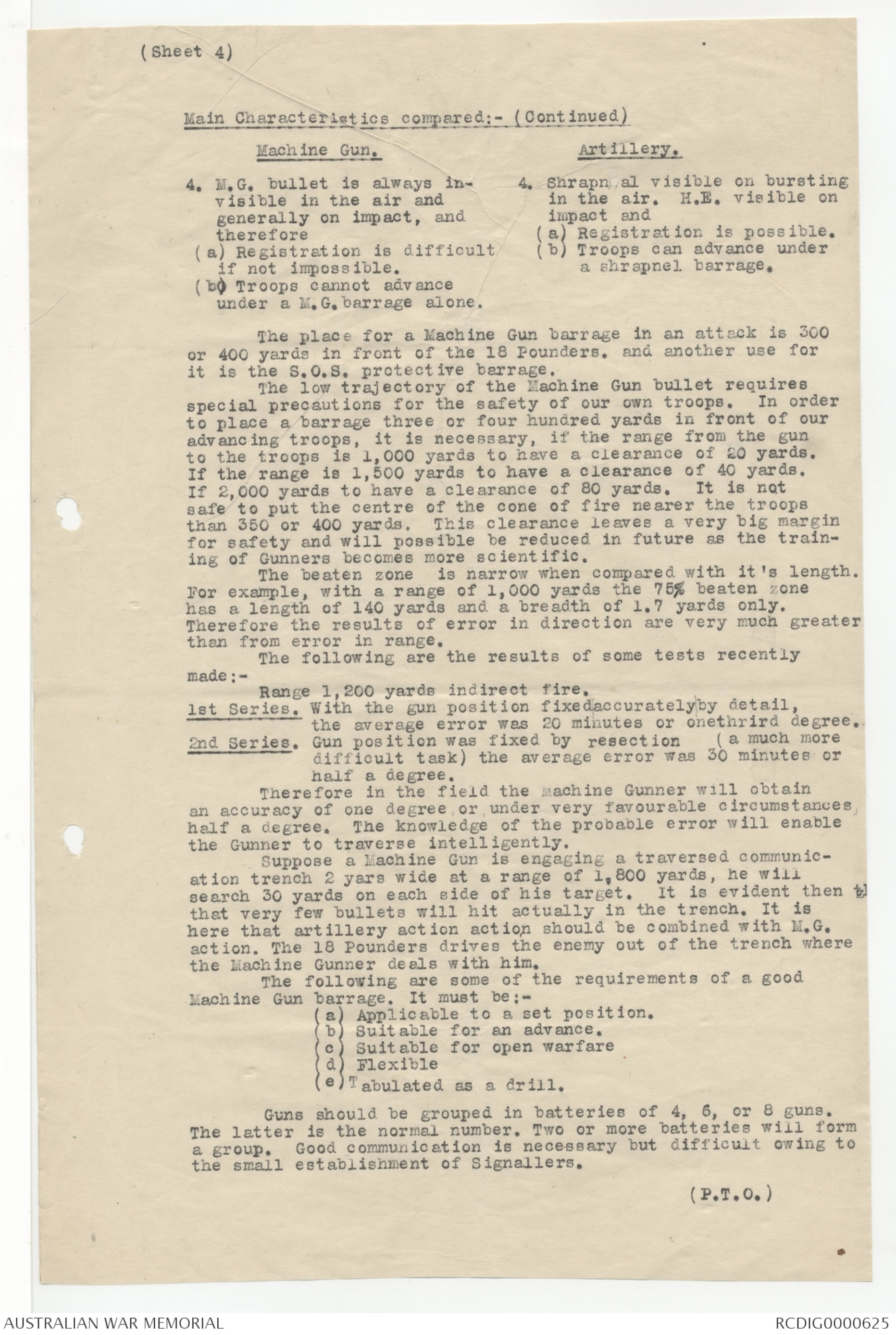
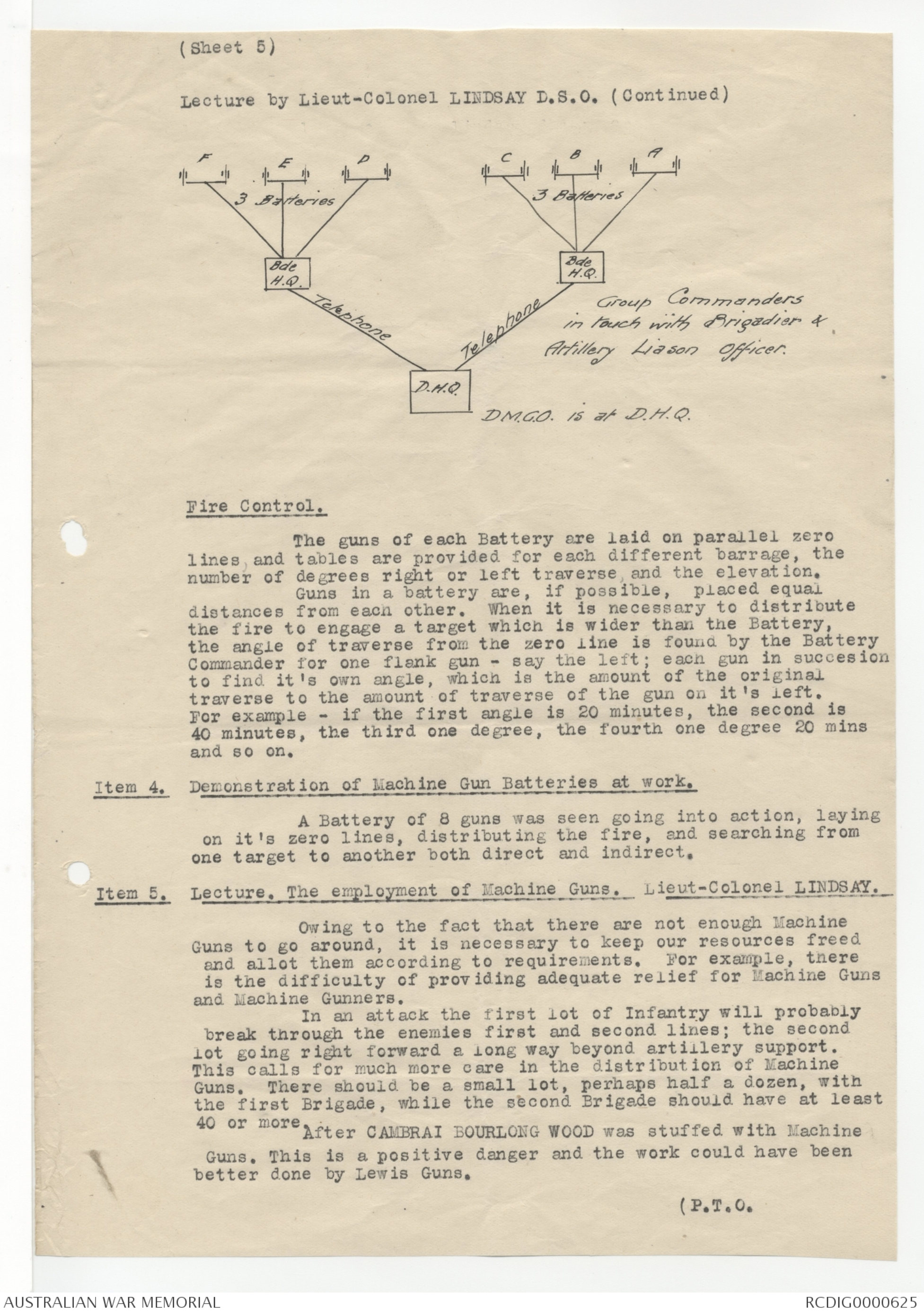
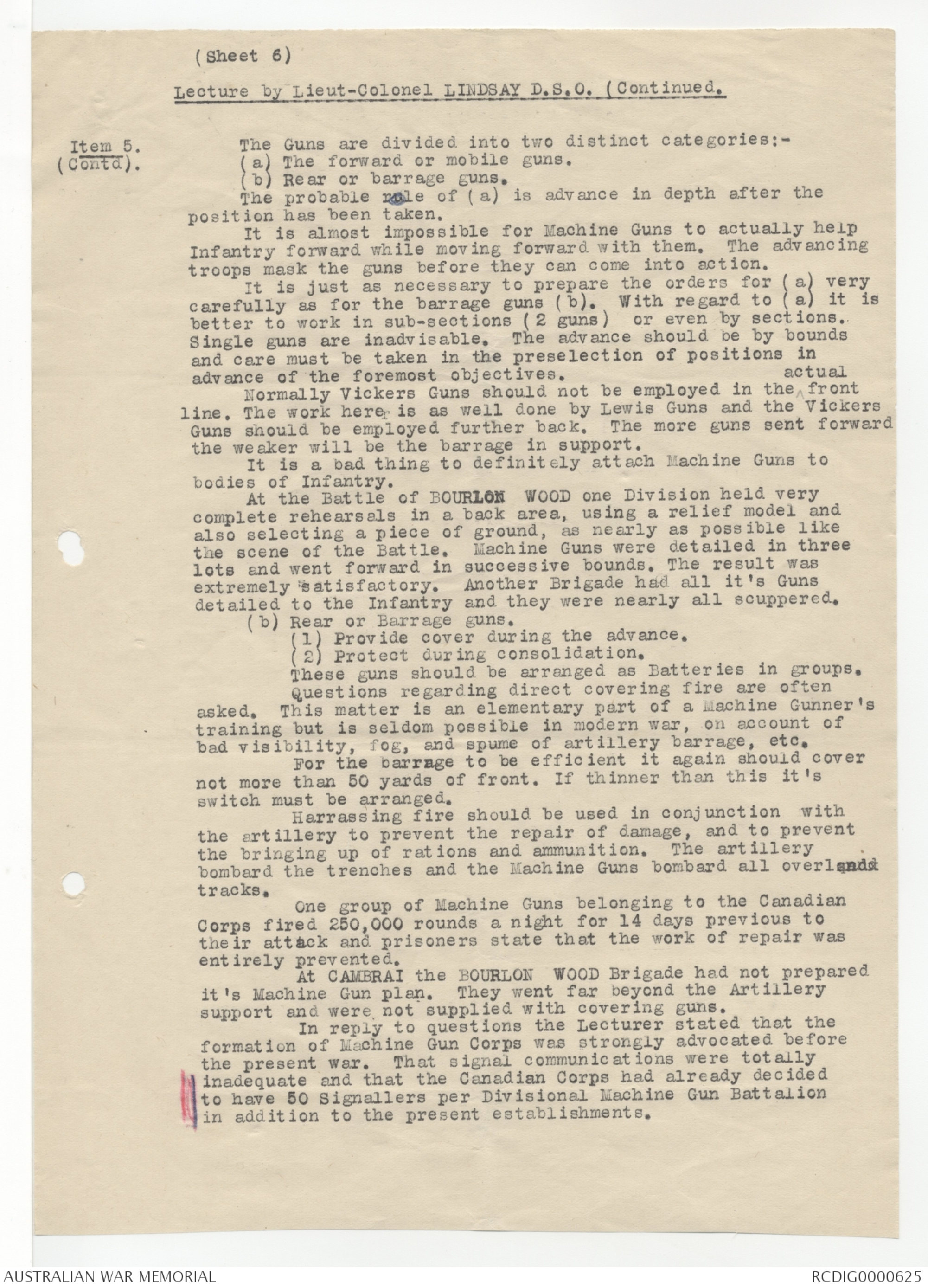
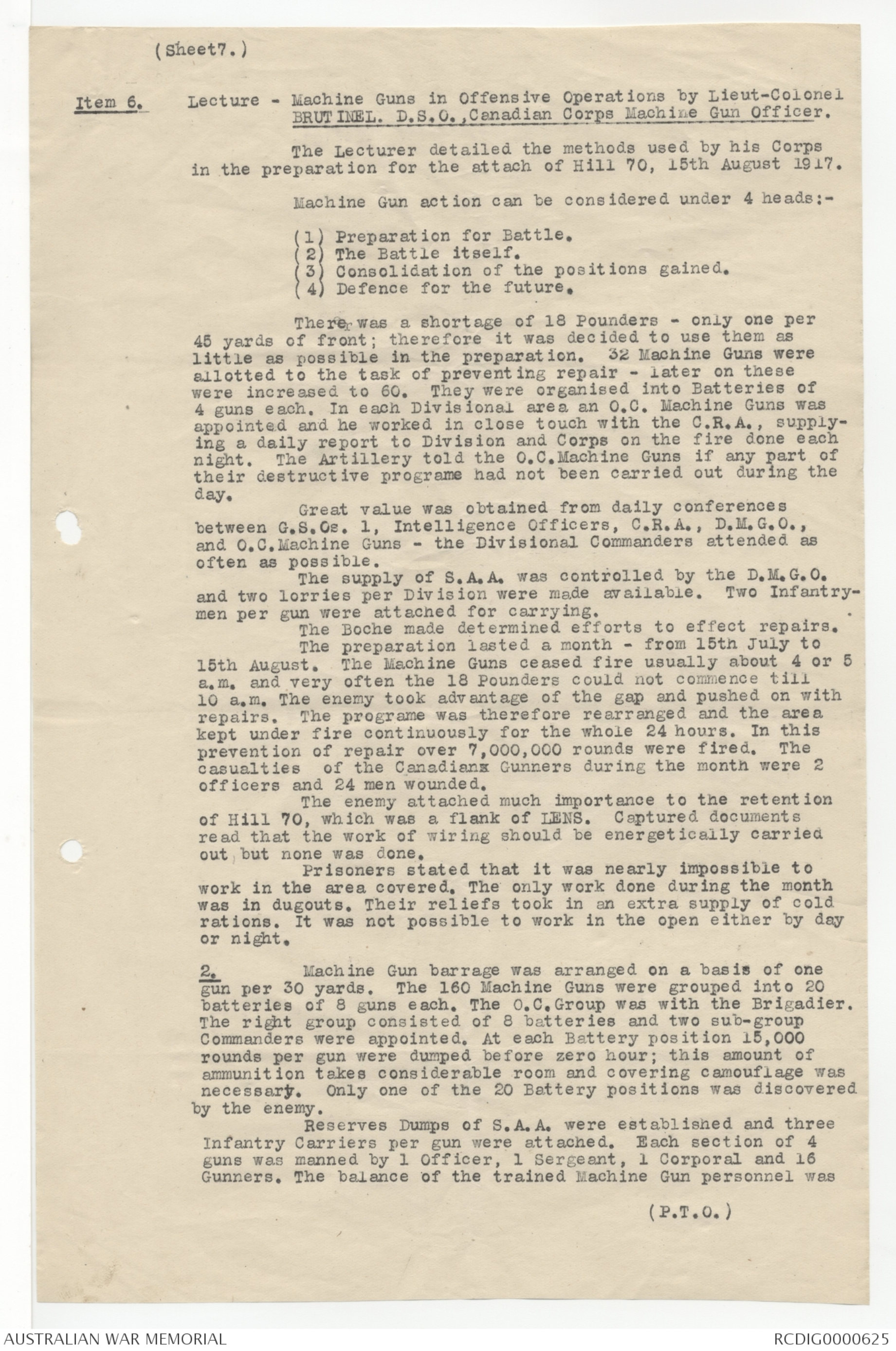


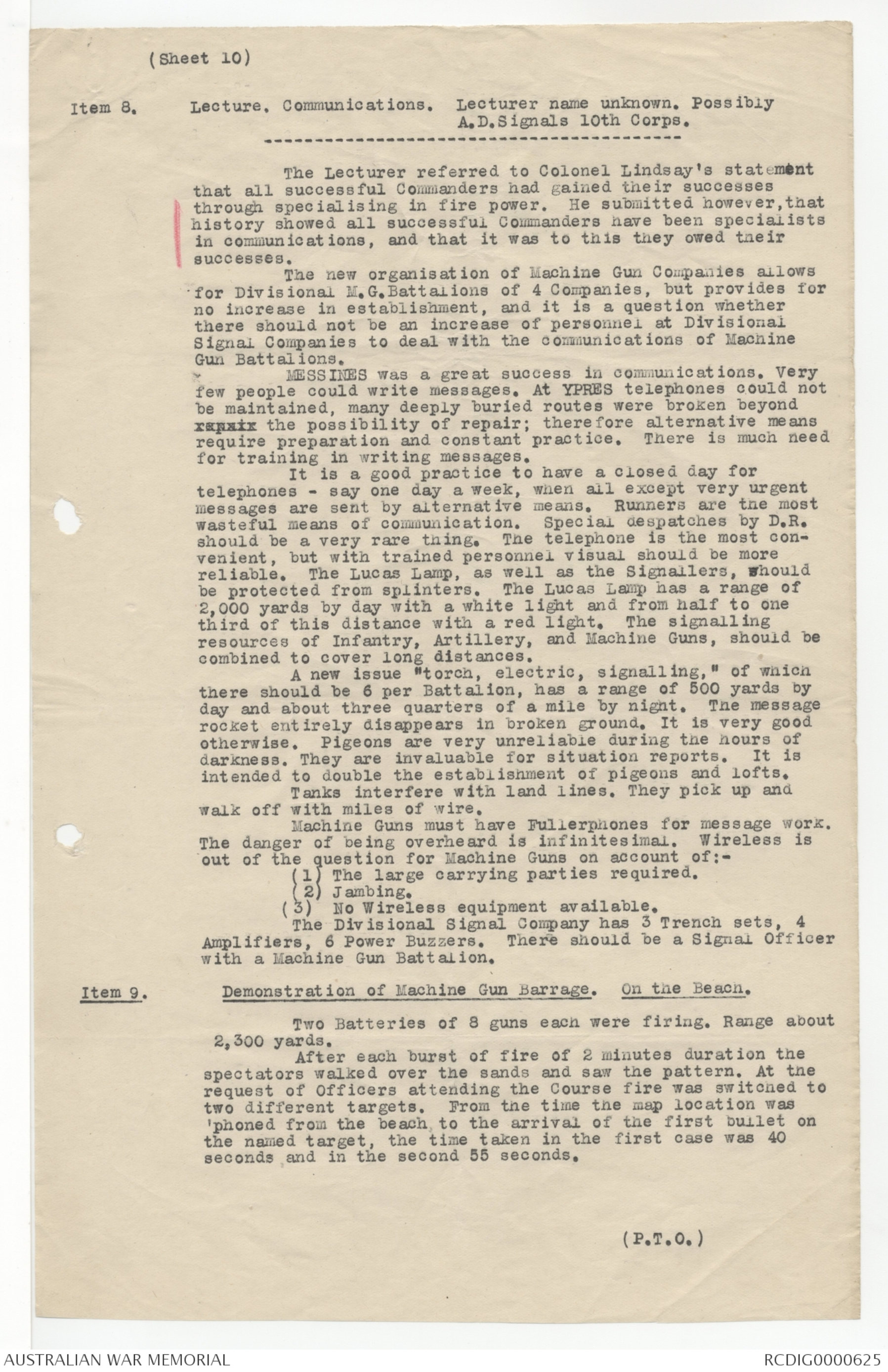
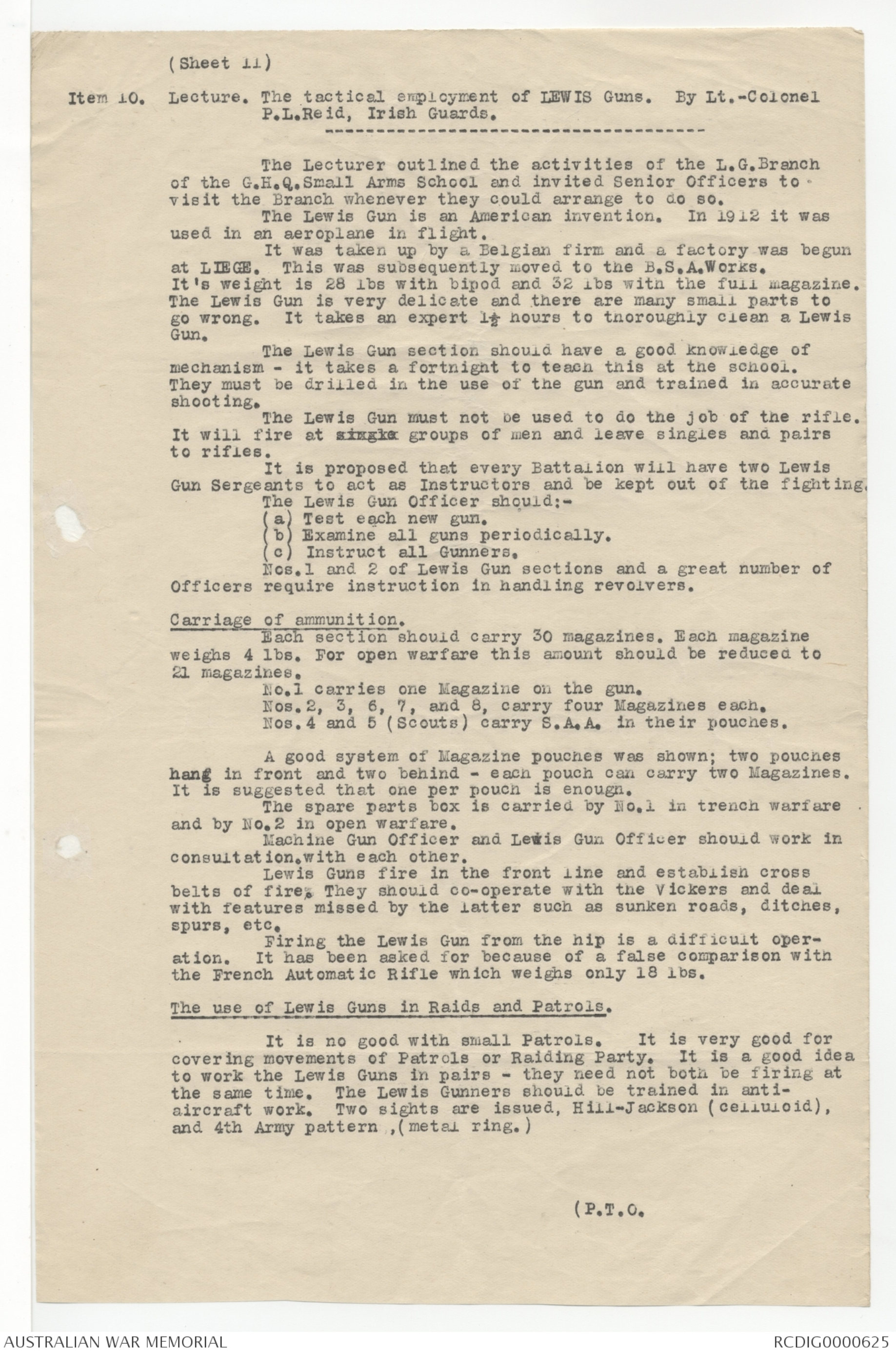
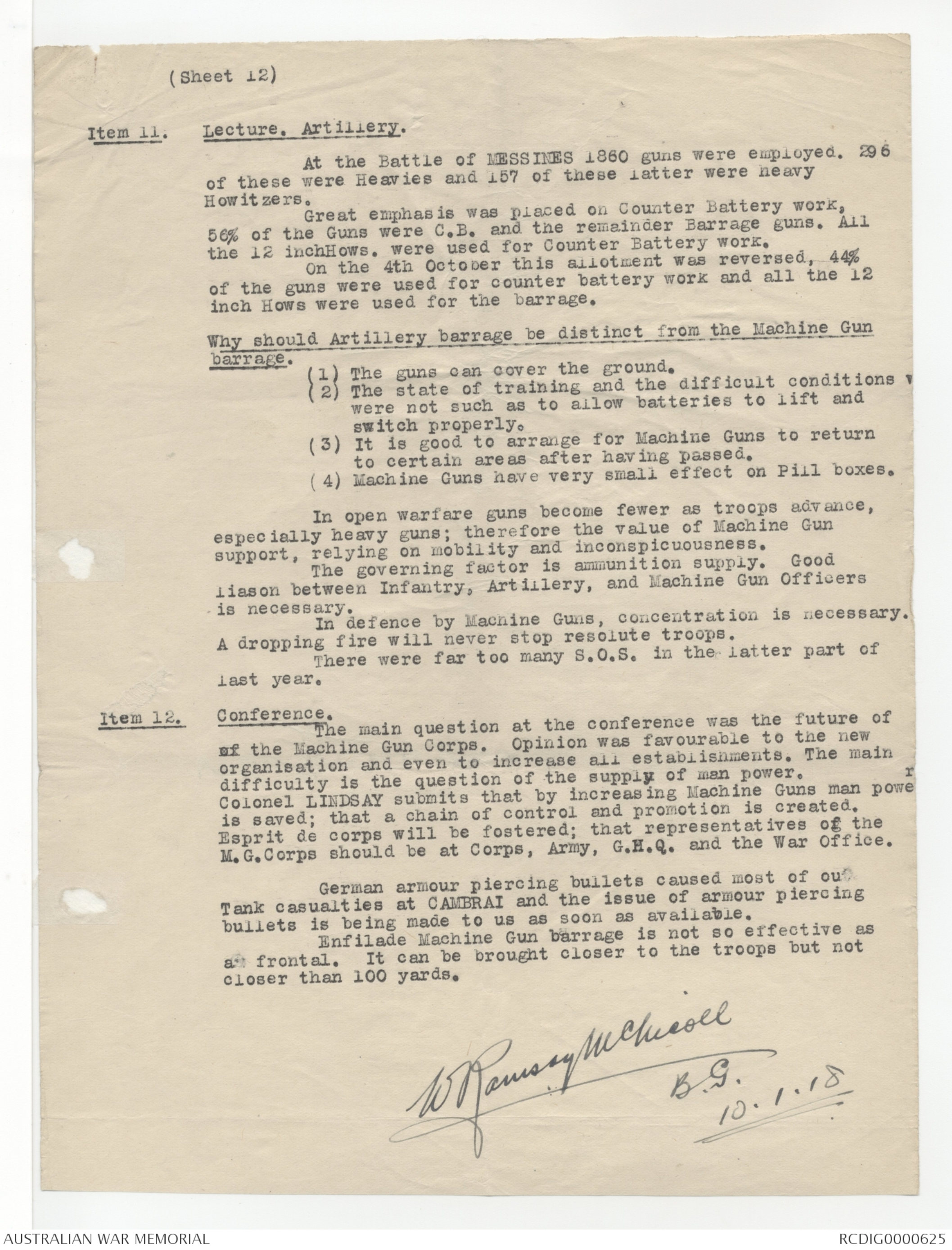
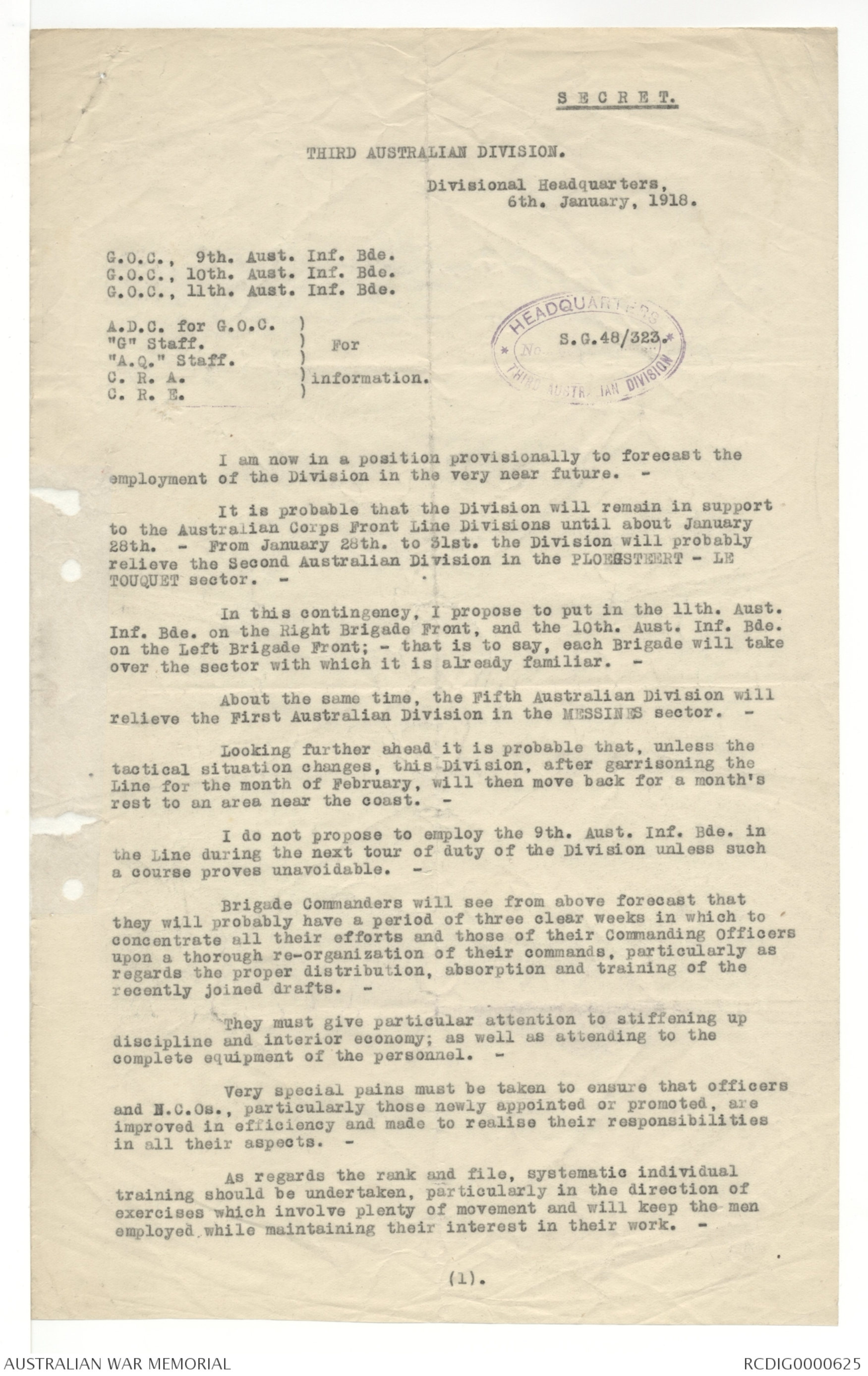
(Sheet 4)
Main Characteristics compared:- (Continued)
Machine Gun. Artillery.
4. M.G. bullet is always 4. Shrapnal visible on bursting
invisible in the air and in the air. H.E. visible on
generally on impact, and impact and
(a) Registration is difficult (a) Registration is possible.
if not possible. (b) Troops can advance under
(b) Troops cannot advance a shrapnel barrage.
under a M.G. barrage alone.
The place for a Machine Gun barrage in an attack is 300
or 400 yards in front of the 18 Pounders. and another use for
it is the S.O.S. protective barrage.
The low trajectory of the Machine Gun bullet requires
special precautions for the safety of our own troops. In order
to place a barrage three or four hundred yards in front of our
advancing troops, it is necessary, if the range from the gun
to the troops is 1,000 yards to have a clearance of 20 yards.
If the range is 1,500 yards to have a clearance of 40 yards.
If 2,000 yards to have a clearance of 80 yards. It is not
safe to put the centre of the cone of fire nearer the troops
than 350 or 400 yards. This clearance leaves a very big margin
for safety and will possible be reduced in future as the training
of Gunners becomes more scientific.
The beaten zone is narrow when compared with it's length.
For example, with a range of 1,000 yards the 75% beaten zone
has a length of 140 yards and a breadth of 1.7 yards only.
Therefore the results of error in direction are very much greater
than from error in range.
The following are the results of some tests recently
made:-
Range 1,200 yards indirect fire.
1st Series. With the gun position fixed accurately by detail,
the average error was 20 minutes or onethrird degree.
2nd Series. Gun position was fixed by resection (a much more
difficult task) the average error was 30 minutes or
half a degree.
Therefore in the field the Machine Gunner will obtain
an accuracy of one degree, or under very favourable circumstances
half a degree. The knowledge of the probable error will enable
the Gunner to traverse intelligently.
Suppose a Machine Gun is engaging a traversed communication
trench 2 yars wide at a range of 1,800 yards, he will
search 30 yards on each side of his target. It is evident then
that very few bullets will hit actually in the trench. It is
here that artillery action action should be combined with M.G.
action. The 18 Pounders drives the enemy out of the trench where
the Machine Gunner deals with him.
The following are some of the requirements of a good
Machine Gun barrage. It must be:-
(a) Applicable to a set position.
(b) Suitable for an advance.
(c) Suitable for open warfare
(d) Flexible
(e) Tabulated as a drill.
Guns should be grouped in batteries of 4, 6, or 8 guns.
The latter is the normal number. Two or more batteries will form
a group. Good communication is necessary but difficult owing to
the small establishment of Signallers.
(P.T.O.)
(Sheet 5)
Lecture by Lieut-Colonel LINDSAY D.S.O. (Continued)
Diagram - see original document
Fire Control.
The guns of each Battery are laid on parallel zero
lines, and tables are provided for each different barrage, the
number of degrees right or left traverse, and the elevation.
Guns in a battery are, if possible, placed equal
distances from each other. When it is necessary to distribute
the fire to engage a target which is wider than the Battery,
the angle of traverse from the zero line is found by the Battery
Commander for one flank gun - say the left; each gun in succesion
to find it's own angle, which is the amount of the original
traverse to the amount of traverse of the gun on it's left.
For example - if the first angle is 20 minutes, the second is
40 minutes, the third one degree, the fourth one degree 20 mins
and so on.
Item 4. Demonstration of Machine Gun Batteries at work.
A Battery of 8 guns was seen going into action, laying
on it's zero lines, distributing the fire, and searching from
one target to another both direct and indirect.
Item 5. Lecture. The employment of Machine Guns. Lieut-Colonel LINDSAY.
Owing to the fact that there are not enough Machine
Guns to go around, it is necessary to keep our resources freed
and allot them according to requirements. For example, there
is the difficulty of providing adequate relief for Machine Guns
and Machine Gunners.
In an attack the first lot of Infantry will probably
break through the enemies first and second lines; the second
lot going right forward a long way beyond artillery support.
This calls for much more care in the distribution of Machine
Guns. There should be a small lot, perhaps half a dozen, with
the first Brigade, while the second Brigade should have at least
40 or more.
After CAMBRAI BOURLONG WOOD was stuffed with Machine
Guns. This is a positive danger and the work could have been
better done by Lewis Guns.
(P.T.O.
(Sheet 6)
Lecture by Lieut-Colonel LINDSAY D.S.O. (Continued.
Item 5. The Guns are divided into two distinct categories:-
(Contd). (a) The forward or mobile guns.
(b) Rear or barrage guns.
The probable role of (a) is advance in depth after the
position has been taken.
It is almost impossible for Machine Guns to actually help
Infantry forward while moving forward with them. The advancing
troops mask the guns before they can come into action.
It is just as necessary to prepare the orders for (a) very
carefully as for the barrage guns (b). With regard to (a) it is
better to work in sub-sections (2 guns) or even by sections.
Single guns are inadvisable. The advance should be by bounds
and care must be taken in the preselection of positions in
advance of the foremost objectives.
Normally Vickers Guns should not be employed in the ^actual front
line. The work here is as well done by Lewis Guns and the Vickers
Guns should be employed further back. The more guns sent forward
the weaker will be the barrage in support.
It is a bad thing to definitely attach Machine Guns to
bodies of Infantry.
At the Battle of BOURLON WOOD one Division held very
complete rehearsals in a back area, using a relief model and
also selecting a piece of ground, as nearly as possible like
the scene of the Battle. Machine Guns were detailed in three
lots and went forward in successive bounds. The result was
extremely satisfactory. Another Brigade had all it's Guns
detailed to the Infantry and they were nearly all scuppered.
(b) Rear or Barrage guns.
(1) Provide cover during the advance.
(2) Protect during consolidation.
These guns should be arranged as Batteries in groups.
Questions regarding direct covering fire are often
asked. This matter is an elementary part of a Machine Gunner's
training but is seldom possible in modern war, on account of
bad visibility, fog, and spume of artillery barrage, etc.
For the barrage to be efficient it again should cover
not more than 50 yards of front. If thinner than this it's
switch must be arranged.
Harrassing fire should be used in conjunction with
the artillery to prevent the repair of damage, and to prevent
the bringing up of rations and ammunition. The artillery
bombard the trenches and the Machine Guns bombard all overland
tracks.
One group of Machine Guns belonging to the Canadian
Corps fired 250,000 rounds a night for 14 days previous to
their attack and prisoners state that the work of repair was
entirely prevented.
At CAMBRAI the BOURLON WOOD Brigade had not prepared
it's Machine Gun plan. They went far beyond the Artillery
support and were not supplied with covering guns.
In reply to questions the Lecturer stated that the
formation of Machine Gun Corps was strongly advocated before
the present war. That signal communications were totally
inadequate and that the Canadian Corps had already decided
to have 50 Signallers per Divisional Machine Gun Battalion
in addition to the present establishments.
(Sheet 7.)
Item 6. Lecture - Machine Guns in Offensive Operations by Lieut-Colonel
BRUTINEL. D.S.O., Canadian Corps Machine Gun Officer.
The Lecturer detailed the methods used by his Corps
in the preparation for the attach of Hill 70, 15th August 1917.
Machine Gun action can be considered under 4 heads:-
(1) Preparation for Battle.
(2) The Battle itself.
(3) Consolidation of the positions gained.
(4) Defence for the future.
There was a shortage of 18 Pounders - only one per
45 yards of front; therefore it was decided to use them as
little as possible in the preparation. 32 Machine Guns were
allotted to the task of preventing repair - later on these
were increased to 60. They were organised into Batteries of
4 guns each. In each Divisional area an O.C. Machine Guns was
appointed and he worked in close touch with the C.R.A., supplying
a daily report to Division and Corps on the fire done each
night. The Artillery told the O.C. Machine Guns if any part of
their destructive programe had not been carried out during the
day.
Great value was obtained from daily conferences
between G.S.Os. 1, Intelligence Officers, C.R.A., D.M.G.O.,
and O.C. Machine Guns - the Divisional Commanders attended as
often as possible.
The supply of S.A.A was controlled by the D.M.G.O.
and two lorries per Division were made available. Two Infantrymen
per gun were attached for carrying.
The Boche made determined efforts to effect repairs.
The preparation lasted a month - from 15th July to
15th August. The Machine Guns ceased fire usually about 4 or 5
a.m. and very often the 18 Pounders could not commence till
10 a.m. The enemy took advantage of the gap and pushed on with
repairs. The programe was therefore rearranged and the area
kept under fire continuously for the whole 24 hours. In this
prevention of repair over 7,000,000 rounds were fired. The
casualties of the Canadians Gunners during the month were 2
officers and 24 men wounded.
The enemy attached much importance to the retention
of Hill 70, which was a flank of LENS. Captured documents
read that the work of wiring should be energetically carried
out, but none was done.
Prisoners stated that it was nearly impossible to
work in the area covered. The only work done during the month
was in dugouts. Their reliefs took in an extra supply of cold
rations. It was not possible to work in the open either by day
or night.
2. Machine Gun barrage was arranged on a basis of one
gun per 30 yards. The 160 Machine Guns were grouped into 20
batteries of 8 guns each. The O.C. Group was with the Brigadier.
The right group consisted of 8 batteries and two sub-group
Commanders were appointed. At each Battery position 15,000
rounds per gun were dumped before zero hour; this amount of
ammunition takes considerable room and covering camouflage was
necessary. Only one of the 20 Battery positions was discovered
by the enemy.
Reserves Dumps of S.A.A. were established and three
Infantry Carriers per gun were attached. Each section of 4
guns was manned by 1 officer, 1 Sergeant, 1 Corporal and 16
Gunners. The balance of the trained Machine Gun personnel was
(P.T.O.)
(Sheet 8)
Item 6. Machine Guns in Offensive Operations (Continued)
(Contd)
kept at B.H.Q. to replace casualties. All M.G. Transport was
pooled under the D.M.G.O. A Repair Shop with an Armourer in
charge, was established in each Divisional area. All spare
parts were pooled and 100 spare barrels were obtained from
Ordnance at Division. These Repair shops proved of very great
value replacing worn barrels, mending casings, and effecting
all repairs very rapidly.
Battery positions were selected well forward to permit
of reaching final S.O.S. line without shifting the guns, therefore
the support fire began at the first objective, which was
the Boche second line.
The enemy made 28 counter attacks in 2 days -the last
being by the 4th Guards Division. They were all unsuccessful.
Machine Guns fired about 10,000,000 rounds during the counter
attacks. Prisoners praise the Machine Gun results very highly
and said that the moral effect was great, the whole of the 4th
Guards Division being demoralised by M.G. fire.
3. Consolidation of Machine Guns.
Machine Guns moved behind the second wave and advanced
by bounds to definitely selected positions as the Infantry
made good their objectives.
It is necessary to keep Machine Guns from being
involved in the fight for progress, this object is for the
Lewis Guns which should fire on the move from the hip (a
good type of sling was shown later by the Lecturer on Lewis
Guns). Eight Guns were allotted to each Brigade - quite
sufficient to organise the defence in depth, the localities
had been previously selected in conference between the
Divisional Commanders and the Brigadiers.
There was intimate liason between Machine Guns and the
nearest Infantry Commander.
These Machine Guns in the forward area were sighted so
as to enfilade the wire at close range and were quite independent
of the Barrage guns.
4. Much fighting took place up to the 24th August and
little work was done. Troops cannot fight and dig at the same
time. Machine Gunners had been in for over 5 weeks and it was
necessary to relieve some of them. The Canadians withdrew 80
Machine Guns leaving 10 Batteries of 8 guns each, grouped
centrally - this gave one gun per 50 yards, but guns were not
to open on their S.O.S. line until the plan of attack was
known, thus 3 concentrations were arranged;-
(Z) Concentration covering left (Northern) half of the
front.
(Y) Concentration covering the right (Southern portion)
overlapping Z concentration slightly in the centre.
(X) Concentration was the extreme Northern flank.
It took less than one minute in all except one Case,
(1½ minutes) to switch on to any one of these concentrations.
This organisation remained in force for 10 days..
A new element was introduced in this fight, namely a
"Sniping Battery", to engage fleeting targets and to allow
consolidation of guns to continue. This Battery of 4 Guns under
an Officer, fired as a Battery at medium and long range to
obtain good patterns. They also engaged aircraft. They are
part of the defensive system and must have plenty of ammunition.
The O.C. Sniping Battery, must be a smart, brainy, dashing
Officer, not hampered by any definite orders.
The Lecturer concluded by answering some questions
regarding organisation used in the Canadian Corps and particularly
stressed the fact that they had found it necessary
to very largely increase the number of Signallers.
(P.T.O.)
(Sheet 9)
Item 7. Lecture. Machine Guns in Defensive Operations. By Lieut-Colonel
Hewitt (M.C.) C.M.G.O. V1th Corps.
The Lecturer began with a brief resuma of the lessons
learnt by the V1th Corps from this and other Wars and on which
it bases it's plan.
In the Manchurian War, 10 years before NEUVE CHAPELLE,
the Japanese completely annihilated a Russian attack by Machine
Gun cross fire.
The Germans working on information supplied by our
Military Attaches in MANCHURIA, began this War with complete
organisation, manned by picked troops. At FESTURERT, 1915,
the method of artillery preparation had not developed but wire
and Machine Guns as in the Manchurian campaign were used by the
Germans.
On the 9th of May the whole of attach was hung up by
Machine Guns; our dead were found lying in regular lines. On
16th May the operation was repeated at night with a similar
result. The Germans sighted the guns to produce bands of fire
at very short range with very little traverse, and showed the
value of fixed lines for S.O.S. in darkness or fog.
Up to the present the Germans have not employed the
overhead screen. This is evidently through ignorance. For example
the enemy recently captured a Graph of an indirect fire barrage
from the 10th Corps. In copying it they made a technical error
which nullified the whole information.
During the 3rd Battle of YPRES the enemy varied his
methods of defence; First. Using defence in depth. Second.
Crowding the front line. Third. A compromise of the two.
At CAMBRAI he fell between the two stools but a new
point was discovered. He had an Army reserve of Machine Guns
which were pushed forward to delay an advance.
It is essential to recognise the principle that Machine
Gun defence is not the same as Rifle defence.
It is impossible to provide a complete screen for the
whole front.
In the V1th Corps, with 2 Divisions in the line and
one in reserve, it is necessary to use two Machine Gun Companies
of the Reserve Division, distributed in the Second and Third
Zones and billeted close to their emplacements.
The Machine Guns have definite instructions to fire
when our front line is bombarded and before the S.O.S. signal.
Then if the front line goes, to switch to some other range line,
It is a good principle to use the guns in pairs.
It is bad to have a succession of lines defended by
Machine Guns, but rather a number of Blocks cemented together
by Corps.
The D.M.G.O. must consult the Brigadier on the work
of Machine Guns and on Brigade requirements.
It is desirable to have tunnelled trenches to but M.G.
emplacements and so to affect:-
(a) The disadvantage of having the Guns in a trench.
(b) The disadvantage of tracks to the Guns.
A Pill Box is considered the the best emplacement at
present.
(P.T.O.)
(Sheet 10)
Item 8. Lecture. Communications. Lecturer name unknown. Possibly
A.D. Signals 10th Corps.
The Lecturer referred to Colonel Lindsay's statement
that all successful Commanders had gained their successes
through specialising in fire power. He submitted however, that
history showed all successful Commanders have been specialists
in communications, and that it was to this they owed their
successes.
The new organisation of Machine Gun Companies allows
for Divisional M.G. Battalions of 4 Companies, but provides for
no increase in establishment, and it is a question whether
there should not be an increase of personnel at Divisional
Signal Companies to deal with the communications of Machine
Gun Battalions.
MESSINES was a great success in communications. Very
few people could write messages. At YPRES telephones could not
be maintained, many deeply buried routes were broken beyondrepair the possibility of repair; therefore alternative means
require preparation and constant practice. There is much need
for training in writing messages.
It is a good practice to have a closed day for
telephones - say one day a week, when all except very urgent
messages are sent by alternative means. Runners are the most
wasteful means of communication. Special despatches by D.R.
should be a very rare thing. The telephone is the most convenient,
but with trained personnel visual should be more
reliable. The Lucas Lamp, as well as the Signallers, should
be protected from splinters. The Lucas Lamp has a range of
2,000 yards by day with a white light and from half to one
third of this distance with a red light. The signalling
resources of Infantry, Artillery, and Machine Guns, should be
combined to cover long distances.
A new issue "torch, electric, signalling," of which
there should be 6 per Battalion, has a range of 500 yards by
day and about three quarters of a mile by night. The message
rocket entirely disappears in broken ground. It is very good
otherwise. Pigeons are very unreliable during the hours of
darkness. They are invaluable for situation reports. It is
intended to double the establishment of pigeons and lofts.
Tanks interfere with land lines. They pick up and
walk off with miles of wire.
Machine Guns must have Fullerphones for message work.
The danger of being overheard is infinitesimal. Wireless is
out of the question for Machine Guns on account of:-
(1) The large carrying parties required.
(2) Jambing.
(3) No Wireless equipment available.
The Divisional Signal Company has 3 Trench sets, 4
Amplifiers, 6 Power Buzzers. There should be a Signal Officer
with a Machine Gun Battalion.
Item 9. Demonstration of Machine Gun Barrage. On the Beach.
Two Batteries of 8 guns each were firing. Range about
2,300 yards.
After each burst of fire of 2 minutes duration the
spectators walked over the sands and saw the pattern. At the
request of Officers attending the Course fire was switched to
two different targets. From the time the map location was
'phoned from the beach, to the arrival of the first bullet on
the named target, the time taken in the first case was 40
seconds and in the second 55 seconds.
(P.T.O.)
(Sheet 11)
Item 10 Lecture. The tactical employment of LEWIS Guns. By Lt.-Colonel
P.L. Reid, Irish Guards.
The Lecturer outlined the activities of the L.G. Branch
of the G.H.Q. Small Arms School and invited Senior Officers to
visit the Branch whenever they could arrange to do so.
The Lewis Gun is an American invention. In 1912 it was
used in an aeroplane in flight.
It was taken up by a Belgian firm and a factory was begun
at LIEGE. This was subsequently moved to the B.S.A. Works.
It's weight is 28 lbs with bipod and 32 lbs with the full magazine.
The Lewis Gun is very delicate and there are many small parts to
go wrong. It takes an expert 1½ hours to thoroughly clean a Lewis
Gun.
The Lewis Gun section should have a good knowledge of
mechanism - it takes a fortnight to teach this at the school.
They must be drilled in the use of the gun and trained in accurate
shooting.
The Lewis Gun must not be used to do the job of the rifle.
It will fire at single groups of men and leave singles and pairs
to rifles.
It is proposed that every Battalion will have two Lewis
Gun Sergeants to act as Instructors and be kept out of the fighting
The Lewis Gun Officer should:-
(a) Test each new gun.
(b) Examine all guns periodically.
(c) Instruct all Gunners.
Nos. 1 and 2 of Lewis Gun sections and a great number of
Officers require instruction in handling revolvers.
Carriage of ammunition.
Each section should carry 30 magazines. Each magazine
weighs 4 lbs. For open warfare this amount should be reduced to
21 magazines.
No. l carries one Magazine on the gun.
Nos. 2, 3, 6, 7, and 8, carry four Magazines each.
Nos. 4 and 5 (Scouts) carry S.A.A. in their pouches.
A good system of Magazine pouches was shown; two pouches
hang in front and two behind - each pouch can carry two Magazines.
It is suggested that one per pouch is enough.
The spare parts box is carried by No. 1 in trench warfare
and by No. 2 in open warfare.
Machine Gun Officer and Lewis Gun Officer should work in
consultation, with each other.
Lewis Guns fire in the front line and establish cross
belts of fire; They should co-operate with the Vickers and deal
with features missed by the latter such as sunken roads, ditches,
spurs, etc.
Firing the Lewis Gun from the hip is a difficult operation.
It has been asked for because of a false comparison with
the French Automatic Rifle which weighs only 18 lbs.
The use of Lewis Guns in Raids and Patrols.
It is no good with small Patrols. It is very good for
covering movements of Patrols or Raiding Party. It is a good idea
to work the Lewis Guns in pairs - they need not both be firing at
the same time. The Lewis Gunners should be trained in anti-aircraft
work. Two sights are issued, Hill-Jackson (celluloid),
and 4th Army pattern, (metal ring.)
(P.T.O.
(Sheet 12)
Item 11. Lecture. Artillery.
At the Battle of MESSINES 1860 guns were employed. 296
of these were Heavies and 157 of these latter were heavy
Howitzers.
Great emphasis was placed on Counter Battery work,
56% of the Guns were C.B. and the remainder Barrage guns. All
the 12 inchHows. were used for Counter Battery work.
On the 4th October this allotment was reversed, 44%
of the guns were used for counter battery work and all the 12
inch Hows were used for the barrage.
Why should Artillery barrage be distinct from the Machine Gun
barrage.
(1) The guns can cover the ground.
(2) The state of training and the difficult conditions
were not such as to allow batteries to lift and
switch properly.
(3) It is good to arrange for Machine Guns to return
to certain areas after having passed.
(4) Machine Guns have very small effect on Pill boxes.
In open warfare guns become fewer as troops advance,
especially heavy guns; therefore the value of Machine Gun
support, relying on mobility and inconspicuousness.
The governing factor is ammunition supply. Good
liason between Infantry, Artillery, and Machine Gun Officers
is necessary.
In defence by Machine Guns, concentration is necessary.
A dropping fire will never stop resolute troops.
There were far too many S.O.S. in the latter part of
last year.
Item 12. Conference
The main question at the conference was the future of
the Machine Gun Corps. Opinion was favorable to the new
organisation and even to increase all establishments. The main
difficulty is the question of the supply of man power.
Colonel LINDSAY submits that by increasing Machine Guns man power
is saved; that a chain of control and promotion is created.
Esprit de corps will be fostered; that representatives of the
M.G. Corps should be at Corps, Army, G.H.Q. and the War Office.
German armour piercing bullets caused most of ou
Tank casualties at CAMBRAI and the issue of armour piercing
bullets is being made to us as soon as available.
Enfilade Machine Gun barrage is not so effective as
a frontal. It can be brought closer to the troops but not
closer than 100 yards.
W Ramsay McNicoll
B.G.
10.1.18
SECRET.
THIRD AUSTRALIAN DIVISION.
Divisional Headquarters,
6th. January, 1918.
G.O.C., 9th. Aust. Inf. Bde.
G.O.C., 10th. Aust. Inf. Bde.
G.O.C., 11th. Aust. Inf. Bde.
A.D.C. for G.O.C. )
"G" Staff. ) For
"A.Q." Staff. )
C. R. A. ) information.
C. R. E. )
S.G.48/323.
I am now in a position provisionally to forecast the
employment of the Division in the very near future. -
It is probable that the Division will remain in support
to the Australian Corps Front Line Divisions until about January
28th. - From January 28th. to 31st. the Division will probably
relieve the Second Australian Division in the PLOEGSTEERT - LE
TOUQUET sector. -
In this contingency, I propose to put in the 11th. Aust.
Inf. Bde. on the Right Brigade Front, and the 10th. Aust. Inf. Bde.
on the Left Brigade Front; - that is to say, each Brigade will take
over the sector with which it is already familiar.
About the same time, the Fifth Australian Division will
relieve the First Australian Division in the MESSINES sector. -
Looking further ahead it is probable that, unless the
tactical situation changes, this Division, after garrisoning the
Line for the month of February, will then move back for a month's
rest to an area near the coast.
I do not propose to employ the 9th. Aust. Inf. Bde. in
the Line during the next tour of duty of the Division unless such
a course proves unavoidable.
Brigade Commanders will see from above forecast that
they will probably have a period of three clear weeks in which to
concentrate all their efforts and those of their Commanding Officers
upon a thorough re-organization of their commands, particularly as
regards the proper distribution, absorption and training of the
recently joined drafts. -
They must give particular attention to stiffening up
discipline and interior economy; as well as attending to the
complete equipment of the personnel.
Very special pains must be taken to ensure that officers
and N.C.Os., particularly those newly appointed or promoted, are
improved in efficiency and made to realise their responsibilities
in all their aspects.
As regards the rank and file, systematic individual
training should be undertaken, particularly in the direction of
exercises which involve plenty of movement and will keep the men
employed while maintaining their interest in their work. -
(1).
 Sam scott
Sam scottThis transcription item is now locked to you for editing. To release the lock either Save your changes or Cancel.
This lock will be automatically released after 60 minutes of inactivity.